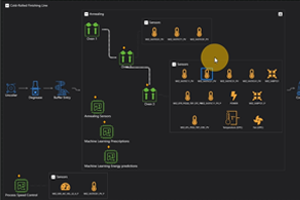The concept of Digital Twin is an essential building block for companies ongoing their digital transformation towards advanced data analytics and Industry 4.0. This virtual replica synchronizing the physical world (such as the structure of an assembly line and its sensors) and a virtual representation of some of its aspects (including real-time data) allows to simulate change to improve future production and enhance knowledge of the production with artificial intelligence models that can learn from historical and live data. Here’s some insights of our expert team on how to leverage this technology to drive successful data science projects in manufacturing.
“As a data scientist, I look at digital twins as a representation of the production lines with all the detailed information regarding sensors and data, and everything that may assist in a successful project”, explains Albert Comellas, Data Scientist at Wizata. “Capturing and organizing the business knowledge of a company is key for the business understanding phase of a data science project.”
Harmonized collaboration for data-driven companies
Digital Twins aren’t just a graphical representation of the manufacturing processes. By standardizing the data and the metadata (information about that data extracted from the business knowledge, such as the position of a machine on the line and its function), other source of information can be structured easily and linked to the Digital Twin, such as computer code, documentation, scientific papers and projects. This is a breakthrough for intensive collaboration, as information can be efficiently shared within the whole company, across different profiles, departments, and information siloes. Everyone gets the same information of all factories across the world, making it easier to achieve global company goals. Employees new to a project or to the company can be onboarded quickly and learn faster about the production.
Understanding processes from top to bottom
So how do we represent a production line? “We start with big blocks that mimic different processes, (e.g.: a heating step), then drill down to lower levels, with specific equipment, machines and sensors.” By visualizing the data in a graphical and interactive way instead of tables, more profiles within companies can understand the data to build advanced analytics on top of it. “When we clearly see how the processes are happening on the digital twin, it helps data scientists and engineers to see all sensors related to the equipment and select in an intuitive way which sensor could be meaningful to a specific problem. We can then test assumptions on which parts of the processes may have an impact on the phenomenon studied. For example, if you are focused on a rolling mill, what happened a station or two before could be of importance. Later, transforming the data into a refined form to build models can also be informed and enhanced by knowing what happened in different part of the production line.” Digital twins can also appeal to different profiles: managers can find it useful to zoom out and have the production lines linked to plants and countries for a global view.
Results in weeks instead of months
Building a Digital Twin is also essential to generate impactful results early on in data science and AI projects, with minimal data. “You don’t have to start by digitalizing everything to generate impactful results: you can begin with one line consisting of only what is meaningful for a project”, details José Andrés García, Lead Data Scientist at Wizata. “If 3 machines are involved in oxidation in a line of 10 machines, you can start by digitizing these three machines and expand later on if necessary.”
Structuring AI and data science projects
With years of experience on the factory floor, the Wizata team infused the Wizata platform and its Digital Twin module with the best data science practices and a fine-tuned methodology. Companies can rapidly build a meaningful representation of processes, digitizing only what is needed to solve business issues, through an intuitive drag & drop interface.
Areas, machines, equipment and sensors can be connected either via a parent-child relationship (such as a sensor in an oven) or via an in-line relationship (such as two ovens along a conveyor belt). In-line relationships metadata on the distance between equipment and machines can be configured for future automatic space and time data realignment, enabling batch history tracking and intelligent solutions. Engineers and data scientists can then explore the data and export the right data for later research & development.
Sharing info within the company but keeping it safe from outside ears
Digital Twins and platforms such as Wizata help companies to capture and centralize knowledge, and companies keen on maintaining their competitive advantage have naturally searched for ways to avoid leaking this information to outside vendors or competitors. This is why more and more companies are choosing private-by-design platform architectures such as the Wizata platform: the data, models, and intellectual property are under the sole control of the customer and cannot be accessed by anyone not permissioned.


